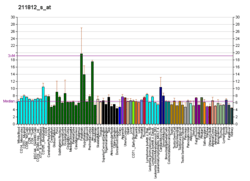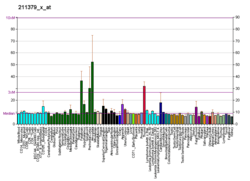B3GALNT1
UDP-GalNAc:beta-1,3-N-acetylgalactosaminyltransferase 1 is an enzyme that in humans is encoded by the B3GALNT1 gene.[3][4][5]
This gene is a member of the beta-1,3-galactosyltransferase (beta3GalT) gene family. This family encodes type II membrane-bound glycoproteins with diverse enzymatic functions using different donor substrates (UDP-galactose and UDP-N-acetylglucosamine) and different acceptor sugars (N-acetylglucosamine, galactose, N-acetylgalactosamine). The beta3GalT genes are distantly related to the Drosophila Brainiac gene and have the protein coding sequence contained in a single exon. The beta3GalT proteins also contain conserved sequences not found in the beta4GalT or alpha3GalT proteins. The carbohydrate chains synthesized by these enzymes are designated as type 1, whereas beta4GalT enzymes synthesize type 2 carbohydrate chains. The ratio of type 1:type 2 chains changes during embryogenesis. By sequence similarity, the beta3GalT genes fall into at least two groups: beta3GalT4 and 4 other beta3GalT genes (beta3GalT1-3, beta3GalT5). The encoded protein of this gene does not use N-acetylglucosamine as an acceptor sugar at all. Multiple transcript variants that are alternatively spliced in the 5' UTR have been described; they all encode the same protein.[5]
References
- ↑ "Human PubMed Reference:".
- ↑ "Mouse PubMed Reference:".
- ↑ Amado M, Almeida R, Carneiro F, Levery SB, Holmes EH, Nomoto M, Hollingsworth MA, Hassan H, Schwientek T, Nielsen PA, Bennett EP, Clausen H (Jun 1998). "A family of human beta3-galactosyltransferases. Characterization of four members of a UDP-galactose:beta-N-acetyl-glucosamine/beta-nacetyl-galactosamine beta-1,3-galactosyltransferase family". J Biol Chem. 273 (21): 12770–8. PMID 9582303. doi:10.1074/jbc.273.21.12770.
- ↑ Okajima T, Nakamura Y, Uchikawa M, Haslam DB, Numata SI, Furukawa K, Urano T, Furukawa K (Jan 2001). "Expression cloning of human globoside synthase cDNAs. Identification of beta 3Gal-T3 as UDP-N-acetylgalactosamine:globotriaosylceramide beta 1,3-N-acetylgalactosaminyltransferase". J Biol Chem. 275 (51): 40498–503. PMID 10993897. doi:10.1074/jbc.M006902200.
- 1 2 "Entrez Gene: B3GALNT1 beta-1,3-N-acetylgalactosaminyltransferase 1 (globoside blood group)".
External links
- Human B3GALNT1 genome location and B3GALNT1 gene details page in the UCSC Genome Browser.
Further reading
- Amado M, Almeida R, Schwientek T, Clausen H (2000). "Identification and characterization of large galactosyltransferase gene families: galactosyltransferases for all functions.". Biochim. Biophys. Acta. 1473 (1): 35–53. PMID 10580128. doi:10.1016/S0304-4165(99)00168-3.
- Kalyanaraman VS, Rodriguez V, Veronese F, et al. (1990). "Characterization of the secreted, native gp120 and gp160 of the human immunodeficiency virus type 1.". AIDS Res. Hum. Retroviruses. 6 (3): 371–80. PMID 2187500. doi:10.1089/aid.1990.6.371.
- Pal R, Hoke GM, Sarngadharan MG (1989). "Role of oligosaccharides in the processing and maturation of envelope glycoproteins of human immunodeficiency virus type 1". Proc. Natl. Acad. Sci. U.S.A. 86 (9): 3384–8. PMC 287137
 . PMID 2541446. doi:10.1073/pnas.86.9.3384.
. PMID 2541446. doi:10.1073/pnas.86.9.3384. - Dewar RL, Vasudevachari MB, Natarajan V, Salzman NP (1989). "Biosynthesis and processing of human immunodeficiency virus type 1 envelope glycoproteins: effects of monensin on glycosylation and transport". J. Virol. 63 (6): 2452–6. PMC 250699
 . PMID 2542563.
. PMID 2542563. - Kozarsky K, Penman M, Basiripour L, et al. (1989). "Glycosylation and processing of the human immunodeficiency virus type 1 envelope protein". J. Acquir. Immune Defic. Syndr. 2 (2): 163–9. PMID 2649653.
- Robinson WE, Montefiori DC, Mitchell WM (1988). "Evidence that mannosyl residues are involved in human immunodeficiency virus type 1 (HIV-1) pathogenesis". AIDS Res. Hum. Retroviruses. 3 (3): 265–82. PMID 2829950. doi:10.1089/aid.1987.3.265.
- Taniguchi N, Makita A (1984). "Purification and characterization of UDP-N-acetylgalactosamine: globotriaosylceramide beta-3-N-acetylgalactosaminyltransferase, a synthase of human blood group P antigen, from canine spleen". J. Biol. Chem. 259 (9): 5637–42. PMID 6425294.
- Maruyama K, Sugano S (1994). "Oligo-capping: a simple method to replace the cap structure of eukaryotic mRNAs with oligoribonucleotides". Gene. 138 (1–2): 171–4. PMID 8125298. doi:10.1016/0378-1119(94)90802-8.
- Suzuki Y, Yoshitomo-Nakagawa K, Maruyama K, et al. (1997). "Construction and characterization of a full length-enriched and a 5'-end-enriched cDNA library". Gene. 200 (1–2): 149–56. PMID 9373149. doi:10.1016/S0378-1119(97)00411-3.
- Almeida R, Amado M, David L, et al. (1998). "A family of human beta4-galactosyltransferases. Cloning and expression of two novel UDP-galactose:beta-n-acetylglucosamine beta1, 4-galactosyltransferases, beta4Gal-T2 and beta4Gal-T3". J. Biol. Chem. 272 (51): 31979–91. PMID 9405390. doi:10.1074/jbc.272.51.31979.
- Hellberg A, Poole J, Olsson ML (2002). "Molecular basis of the globoside-deficient P(k) blood group phenotype. Identification of four inactivating mutations in the UDP-N-acetylgalactosamine: globotriaosylceramide 3-beta-N-acetylgalactosaminyltransferase gene". J. Biol. Chem. 277 (33): 29455–9. PMID 12023287. doi:10.1074/jbc.M203047200.
- Strausberg RL, Feingold EA, Grouse LH, et al. (2003). "Generation and initial analysis of more than 15,000 full-length human and mouse cDNA sequences". Proc. Natl. Acad. Sci. U.S.A. 99 (26): 16899–903. PMC 139241
 . PMID 12477932. doi:10.1073/pnas.242603899.
. PMID 12477932. doi:10.1073/pnas.242603899. - Clark HF, Gurney AL, Abaya E, et al. (2003). "The Secreted Protein Discovery Initiative (SPDI), a Large-Scale Effort to Identify Novel Human Secreted and Transmembrane Proteins: A Bioinformatics Assessment". Genome Res. 13 (10): 2265–70. PMC 403697
 . PMID 12975309. doi:10.1101/gr.1293003.
. PMID 12975309. doi:10.1101/gr.1293003. - Ota T, Suzuki Y, Nishikawa T, et al. (2004). "Complete sequencing and characterization of 21,243 full-length human cDNAs". Nat. Genet. 36 (1): 40–5. PMID 14702039. doi:10.1038/ng1285.
- Hellberg A, Ringressi A, Yahalom V, et al. (2004). "Genetic heterogeneity at the glycosyltransferase loci underlying the GLOB blood group system and collection". Br. J. Haematol. 125 (4): 528–36. PMID 15142124. doi:10.1111/j.1365-2141.2004.04930.x.
- Gerhard DS, Wagner L, Feingold EA, et al. (2004). "The Status, Quality, and Expansion of the NIH Full-Length cDNA Project: The Mammalian Gene Collection (MGC)". Genome Res. 14 (10B): 2121–7. PMC 528928
 . PMID 15489334. doi:10.1101/gr.2596504.
. PMID 15489334. doi:10.1101/gr.2596504. - Kimura K, Wakamatsu A, Suzuki Y, et al. (2006). "Diversification of transcriptional modulation: Large-scale identification and characterization of putative alternative promoters of human genes". Genome Res. 16 (1): 55–65. PMC 1356129
 . PMID 16344560. doi:10.1101/gr.4039406.
. PMID 16344560. doi:10.1101/gr.4039406. - Otsuki T, Ota T, Nishikawa T, et al. (2007). "Signal sequence and keyword trap in silico for selection of full-length human cDNAs encoding secretion or membrane proteins from oligo-capped cDNA libraries.". DNA Res. 12 (2): 117–26. PMID 16303743. doi:10.1093/dnares/12.2.117.
- Umeyama H, Iwadate M, Taguchi YH (2014). "TINAGL1 and B3GALNT1 are potential therapy target genes to suppress metastasis in non-small cell lung cancer.". BMC Genomics. 15 (Suppl 9): S2. PMC 4290609
 . PMID 25521548. doi:10.1186/1471-2164-15-S9-S2.
. PMID 25521548. doi:10.1186/1471-2164-15-S9-S2.

